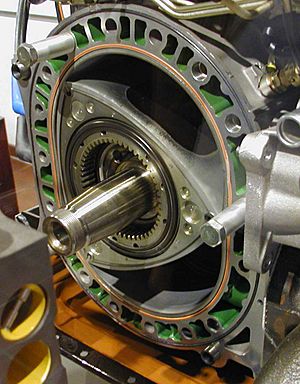Wankel engine facts for kids

The Wankel engine is a special type of engine. It is sometimes called a rotary engine. Unlike most car engines that use pistons moving up and down, the Wankel engine uses a triangle-shaped part that spins around. This makes it smaller and simpler than a regular piston engine.
However, Wankel engines have a challenge. They tend to burn a little bit of oil along with the fuel. This can cause more pollution and wastes oil. Because of this, most cars today still use piston engines.
Contents
What is a Wankel Engine?
A Wankel engine is a type of engine that turns fuel into power by spinning. Instead of pistons that go back and forth, it has a rotor. This rotor is shaped like a triangle with curved sides. It spins inside a special chamber.
How Does a Rotary Engine Work?
The Wankel engine works in four steps, just like a piston engine, but in a different way:
- Intake: As the rotor spins, it creates a space that gets bigger. This pulls in a mix of air and fuel.
- Compression: The rotor keeps spinning, making the space smaller. This squeezes the air and fuel mix very tightly.
- Combustion: A spark plug ignites the squeezed mix. This causes a small explosion that pushes the rotor.
- Exhaust: The rotor continues to move, pushing out the burnt gases through an exhaust port.
This process happens smoothly as the rotor spins, making the engine very quiet and balanced.
Who Invented the Wankel Engine?
The Wankel engine was invented by a German engineer named Felix Wankel. He started working on his ideas in the 1920s. The first working Wankel engine was built in 1957.
Early Development and Use
The first car to use a Wankel engine was the NSU Spider in 1964. Later, the NSU Ro 80 also used this engine. Mazda, a Japanese car company, became very famous for using Wankel engines. They used them in many of their sports cars, like the RX-7 and RX-8.
Advantages of Wankel Engines
Wankel engines have several cool benefits:
- Compact Size: They are much smaller and lighter than piston engines of the same power. This saves space in a vehicle.
- Fewer Parts: They have fewer moving parts, which can make them simpler to build.
- Smooth Operation: Because the rotor spins, Wankel engines are very smooth and quiet. They don't vibrate as much as piston engines.
Challenges of Wankel Engines
Even with their benefits, Wankel engines have some difficulties:
- Fuel and Oil Use: They can use more fuel and oil than piston engines.
- Sealing Issues: The tips of the rotor need special seals (called apex seals) to work well. These seals can wear out over time.
- Emissions: Burning oil can lead to more pollution, which is a big concern for the environment.
Where Are Wankel Engines Used?
Even though they are not common in everyday cars, Wankel engines have been used in interesting ways:
- Sports Cars: Mazda used them in popular sports cars like the RX-7 and RX-8.
- Motorcycles: Some motorcycles, like the Norton Classic, have used Wankel engines.
- Aircraft: Their small size and light weight make them useful for some small airplanes and drones.
- Other Uses: They have also been used in things like chainsaws and generators.
The Future of Rotary Engines
Engineers are still working on new ways to improve the Wankel engine. Some are looking into using them with electric motors in hybrid cars. Others are exploring different fuels, like hydrogen, to reduce pollution. The Wankel engine remains an interesting and unique part of engine history.
Images for kids
See also
 In Spanish: Motor Wankel para niños
In Spanish: Motor Wankel para niños







